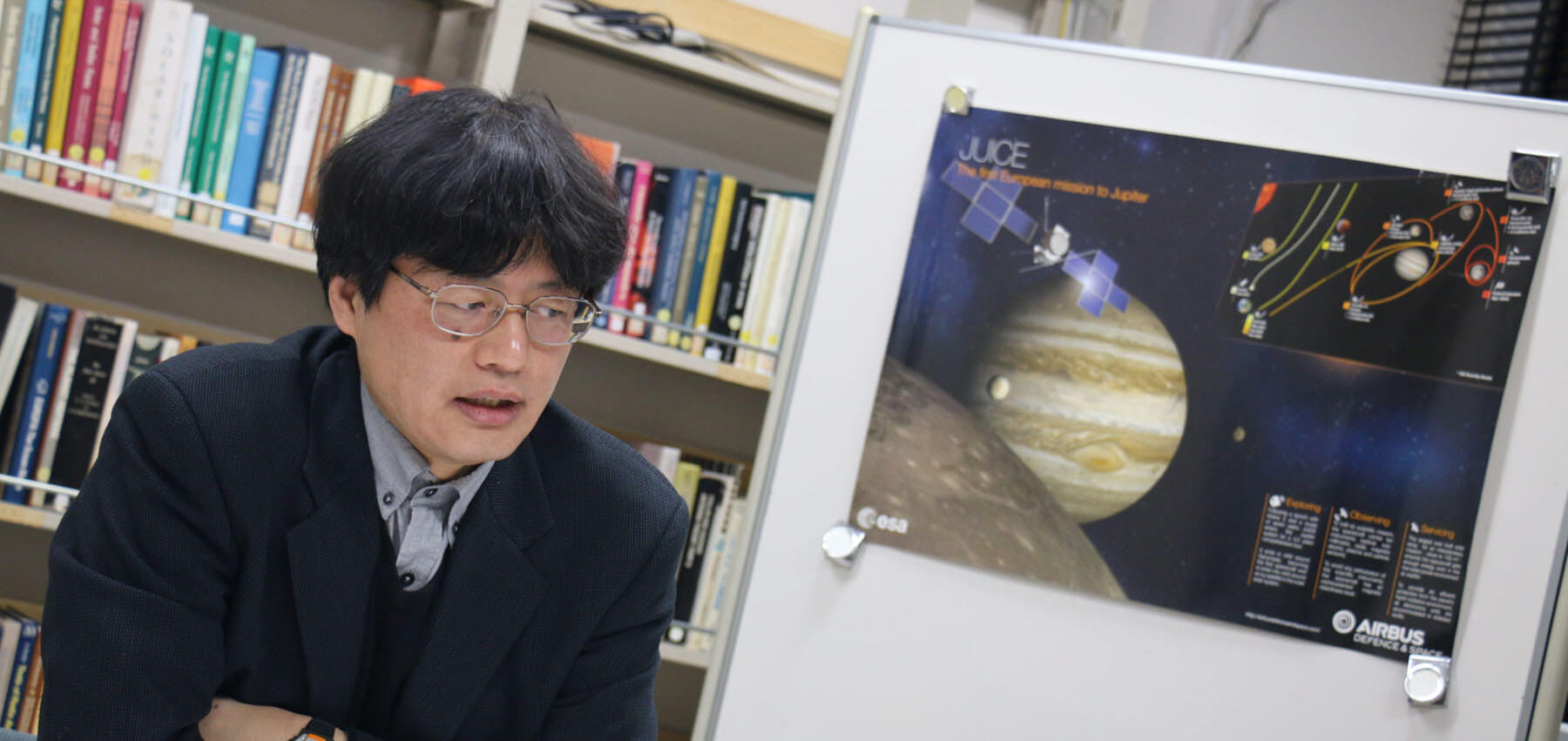
Vol. 5 / 2018.10.5
JUICE Player Interviews
Background to research and development leading up to JUICE
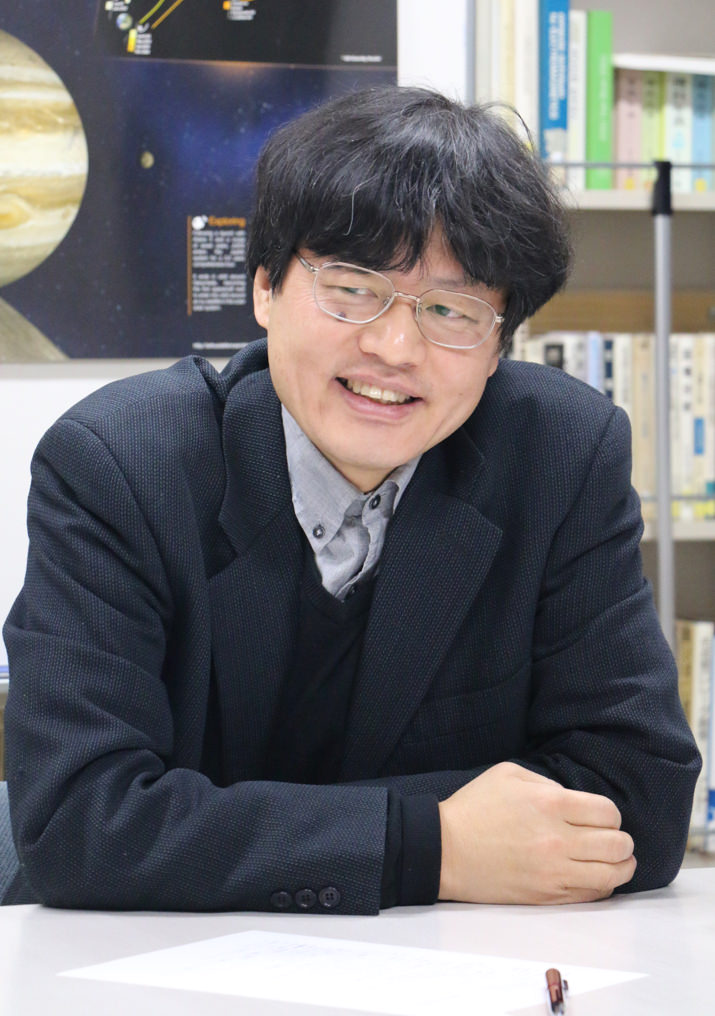
——The fifth interview is with Tohoku University Professor Yasumasa Kasaba, who is the Primary Investigator on the Japan side (Co-PI) for the JUICE radio and plasma wave instrument (RPWI) team.
Looking at your career, it seems that you have experience in areas outside of research, but please can you tell us how you came back to research?
Dr. Kasaba:
I was a student at the Faculty of Science (Department of Physics) atKyoto University, and I got my Master’s degree in infrared sensor development for the Subaru Telescope, which had just started to be constructed at that time. After that, I was a director of economics, science and culture at NHK Osaka Broadcasting. This was when I started thinking that, even though I like science, engineering also seems to be interesting.
That’s why I went back to Kyoto University, this time to the School of Electrical and Electronic Engineering in the Faculty of Engineering, where things developed unexpectedly as I wrote a doctoral thesis on the GEOTAIL magnetosphere tail observation satellite, which was the first joint Japan-U.S. project. I got my PhD even while I continued to think about how strange it is to have pursued development in the science department and science in the engineering department.
After that, I became an assistant in electromagnetic wave engineering at University of Toyama, where a post just happened to be available. It was at this laboratory that I first encountered the Mars explorer NOZOMI, which was supposed to have been Japan’s first planetary orbiting probe.
The team was a collaboration between Tohoku university, Kanazawa university, and University of Toyama, and, taking over from my predecessor who moved to America, while travelling between Toyama, Kanazawa and Sagamihara, I took on the development of the Nozomi flight model.
——What is the backstory to your move to JAXA? What kind of work were you involved in?
Dr. Kasaba:
The group formed by ISAS, Tohoku university and Kyoto university, which had been a source of support in our field, was founded on the RF Engineering group at Kyoto university that had been performing long-distance radio wave transmission and ionospheric observations for that purpose. In connection to this, I transferred to become an assistant at the Institute of Space and Astronautical Science before it became JAXA. At the “PLAIN Center” that handled computers, networks and databases, I took the lead on dealing with the unseen side of things at ISAS. In 2003, when JAXA was established, I was a behind-the-scenes representative at Sagamihara for information systems and information-related work.
In terms of satellites, in December 1998, while I was at University of Toyama, I provided support for NOZOMI, which had engine trouble when performing a swing-by of Earth, and I was on operating duty when the fatal power issue occurred in April 2002, after which we walked an operative tightrope as we cared for the probe until, finally, it met its end in December 2003. I also had various tasks as a support officer in the incident investigation.
As a follow-up to NOZOMI, there was already some talk about the Venus climate orbiter AKATSUKI. An infrared camera using the sensor that was the theme of my master’s thesis was installed on this probe, and I assisted with the necessary calculations and such. Meanwhile, there was also talk of the Japan-Europe joint Mercury Orbiter BepiColombo as a development in collaboration with Europe that included NOZOMI, and I took charge of the general monitoring equipment for use at Mercury. Until 2007, when I was at ISAS, I provided behind-the-scenes work at JAXA at Sagimihara, in particular, assisted with the incident investigation report for NOZOMI and the development of general monitoring equipment for Mercury for BepiColombo, and I worked on the Venus orbiter.
——How have things been since you moved to Tohoku University?
Dr. Kasaba:
I enjoyed being at JAXA, but just as I was thinking about what will happen in my life and with “Nozomi” on my mind, despite having a doctorate in engineering, I was drawn back to the Faculty of Science at Tohoku University, where I returned to the scene for actual work.
At university, there are people in a wide range of different fields, as well as a huge number of lively students, so it is a lot of fun. I didn’t think I was well-suited to being a teacher, though. I am thankful that my job involves contact with some amazing graduate students. As for the cold weather in Sendai, which I had never experienced before, and the March 11 earthquake, these things were unexpected, but at the time of the earthquake, my reflex action was to consider the “emergency response” and “guarantee of safety” that is used in space, which proved useful.
Leading up to the JUICE Project
——Please can you tell us the story of how you came to participate in the JUICE project that is led by ESA?
Dr. Kasaba: Since I moved to Tohoku University, as a “follow-up” to the Japan-Europe collaboration on the Mercury probe, studies regarding JUICE have been promoted by three parties, namely, Japan, Europe and the U.S. As a result, following on from the original probe that Japan considered providing, we are providing cooperative participation in the monitoring equipment for JUICE. This is the first time that Japan alone has developed equipment that will go beyond a Mars orbiter. The U.S. was also moving forward with its own Europa Clipper orbiter, but they ended up cooperating on JUICE.
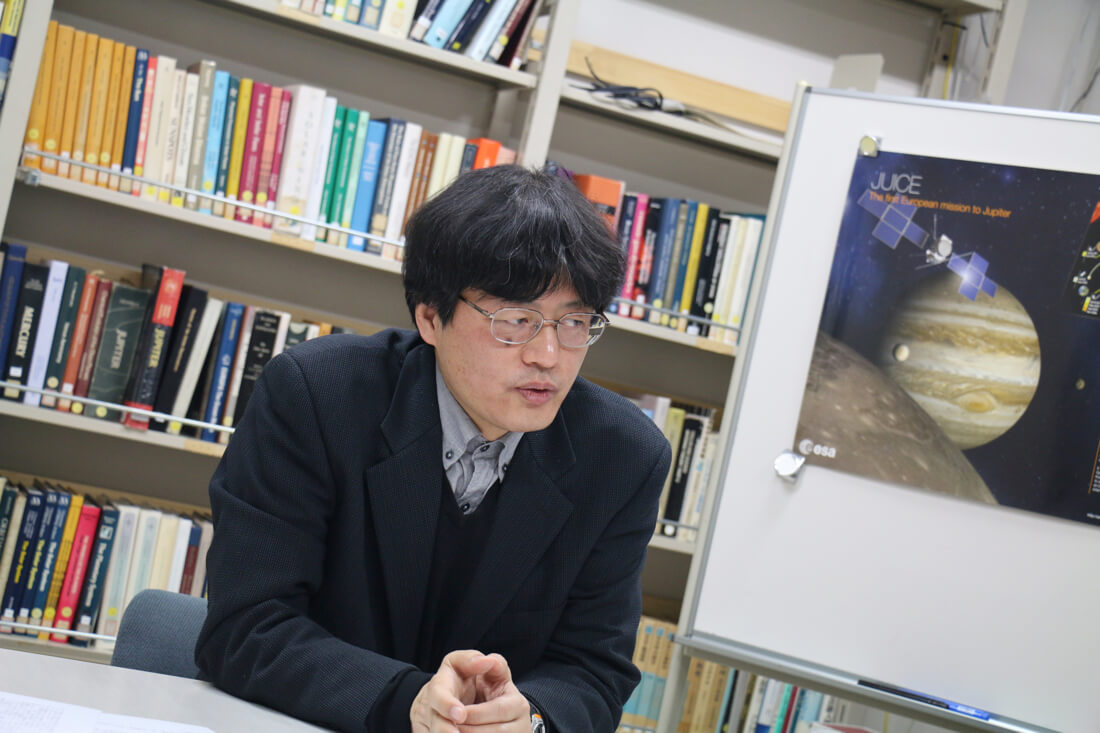
After I moved to Tohoku University, I took over from the general manager of radio wave and plasma wave investigation (PWI) for BepiColombo. The Sweden-France part of this team includes operating members from the European side of JUICE, and so JUICE naturally became “the next project.” At Tohoku University, there are some pioneering researchers of outer planets in Japan who have been promoting studies of Jupiter for decades and who have developed above-ground observation equipment in Miyagi, Fukushima and Hawaii. I am not an alumnus of this University but as a current member of staff at Tohoku University, I work with a sense of responsibility when participating in the JUICE project because of the pride taken in these senior members and the history and achievements of the University.
The trusting relationship between the European Space Agency (ESA) and JAXA from BepiColombo was built up by senior members. The members from the Bepi project at ESA, AirBus, which was the main manufacturer, and in monitoring equipment on the European side are largely the same as those involved in JUICE, and it truly is an honor to frequently meet with these people.
BepiColombo was launched in 2018 and it will make orbiting observations of Mercury in 2025-2026. JUICE will launch in 2022, and it is scheduled to make orbiting observations of Jupiter in 2030. They will operate simultaneously until 2026, and so we can carry out construction with a design that is mutually beneficial. There will truly be many things to discuss and coordinate during these decades with the European side, and this is now underway.
RPWI equipment installed on JUICE
——Please can you tell us about the RPWI that you are responsible for?
Dr. Kasaba:
RPWI measures the intense radio wave activity emitted by Jupiter, electric and magnetic field waves showing high-temperature plasma disturbances that cover Jupiter and its moons, and the density and temperature of the dense ionosphere surrounding the icy moons. With a design concept that “takes the best of both worlds” from the RPWS (U.S.-Europe collaboration team) installed on the Cassini Saturn probe and the PWI (Japan-Europe collaboration team) from BepiColombo on which I worked as a lead researcher, the functions and performance have been greatly improved in all areas in comparison to the equipment installed on the former U.S. Galileo probe that orbited Jupiter and the current U.S. Juno probe that is making observations in orbit.
RPWI comprises four sensors that measure low-temperature plasma density and temperature and low-frequency electric field waves (LP: Langmuir Probe), a three-axis sensor that measures low-frequency magnetic field waves (SCM: Search Coil Magnetometer), a three-axis sensor that measures radio waves (RWI: Radio Wave Instrument) and a receiver that connects to all of these.
For JUICE as a whole, this is essential information about the magnetosphere that surrounds Jupiter and Galileo, and about the quantity and character of various activities on the lines of magnetic force that connect them. It also supports the acquisition of electrical information essential to perceiving the low-temperature atmosphere and dust that arise from the icy moons, and the verification of the existence of a “sea” (that permits the flow of electricity because it is composed of salty water, as opposed to the icy crust) hidden below the surface of the icy moons.
The Japan side team is composed of a “joint team of Tohoku University + Kanazawa University/Kyoto University/Nagoya University, etc.,” which also supported Geotail, Nozomi, BepiColombo and Arase, and, in cooperation with the Sweden, Poland and France team, the Japan side team is providing a RWI antenna, a connecting high frequency receiver, and digital data processing. This “high frequency measurement equipment” (80kHz - 45MHz) is the first to include the capacity to find radio wave direction in orbit around Jupiter, and it achieves a sensitivity that is more than twice that of Galileo and Juno.
The Japan-side team also installed the radar probe equipment for Nozomi and the Kaguya lunar probe, and, although it unfortunately was not put into use in Nozomi, with Kaguya, it did contribute to the search for historic crust formation based on lava activity in the past that is hidden under the surface of the moon and the discovery of hollow rock tubes. At this time, it was confirmed that there is a “radio wave echo” in which auroral radio emitted by the Earth is reverberated and returned by the lunar surface.
With JUICE, a reverberated echo is produced from the surface or below the surface of the icy moon due to the more powerful Jupiter radio waves. For this reason, we may be able to directly perceive the “top of the underground sea” that may reach tens of kilometers below the surface. This “passive radar function,” which has become a hot topic for the entire JUICE science team, is being investigated urgently.
and now is the time
——You are the Japan side PI for the PWI on the BepiColombo Mercury orbiter, but is this greatly different from the RPWI for JUICE?
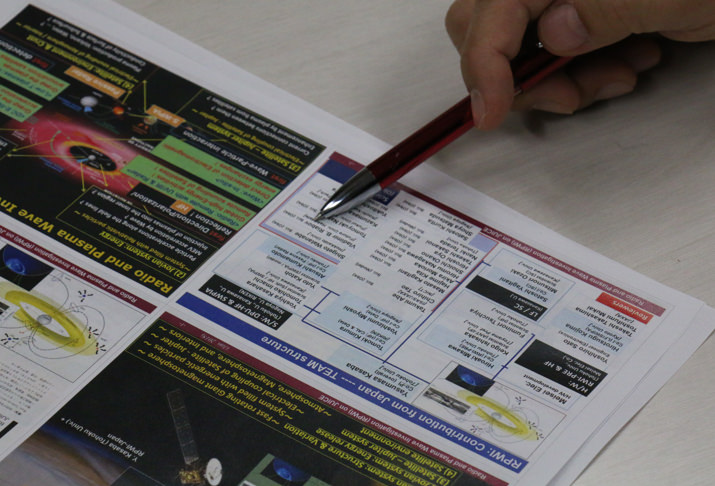
Dr. Kasaba:
The general manager for the JUICE RPWI team is Professor Jan-Erik Wahlund of Sweden, who was also a manager on the European side for the PWI team in BepiColombo. There is a big overlap in the members of these projects. The development of this monitoring equipment can only be achieved by a U.S. university alliance (University of Iowa, University of Minnesota, University of Colorado and University of California, etc.), a European alliance (Sweden, France, Czech Republic and Poland, etc.) and the Japan team.
Monitoring equipment is selected by international competition, but RPWI was originally covered along with everything else by the Europe-U.S.-Japan cooperative team. Regarding this equipment, we are the only ones capable of this development and observation. As the situation of the budget for the U.S. side deteriorated, it became a Europe-Japan alliance, that is, the structure became almost the same as that of the BepiColombo PWI team.
As for the development areas for Japan, which started out from the BepiColombo PWI designs that were developments of the Nozomi Mars lander and the Kaguya lunar orbiter, developments have been made through many difficulties so that functionality is possible even in the harsh radiation and extremely cold environment of Jupiter. The development of the Arase geospace radiation belt observer that launched at the end of 2016 was in fact preceded by developments for JUICE, so those designs were also incorporated. For that reason, key areas could be verified in “Arase.” In particular, it has already been operating in Earth’s radiation belt for one year, which is an area with a harsh environment second only to that of Jupiter.
Spacecraft, for which there are few development opportunities, cannot be repaired even if they breakdown, and it is difficult to investigate the cause of any malfunctions. In that sense, all of the know-how built up in related projects is being brought together in a good way.
For the success of the Project
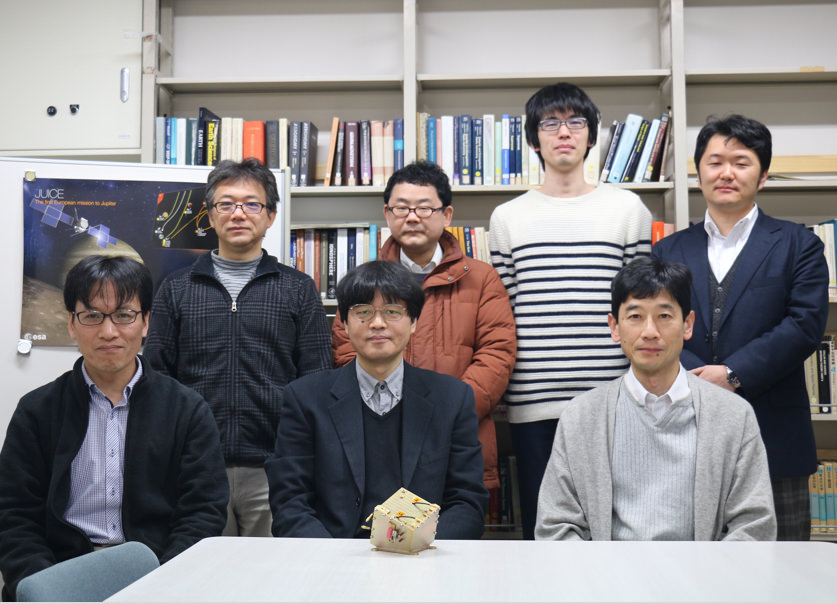
——What do you think is important in order to move forward with the JUICE Project?
Dr. Kasaba:
JUICE will arrive at Jupiter in 2029 and will come to an end in 2033. I will retire in 2031 [laughs]. It’s a lifelong contest. Even though I’m giving everything I’ve got, it may end without results, like Nozomi. I have to give it my all so that doesn’t happen. I don’t think there will be a repeat of the Nozomi situation.
In research, by standing on the shoulders of those who have come before us, results can be achieved by an individual in one attempt. However, for the “development and manufacturing” of lunar/space probes, it is necessary to have knowledge and tough prior experiences with a background in strict logic, test results, material characteristics and a variety of other elements, which is something that can only be acquired over time.
As much experience, ability and knowledge as possible are required when talking with the space agencies that take overall responsibility and with manufacturers, among others. The development of monitoring equipment depends on the request made to the manufacturer. It is also necessary to have the capacity to deal with really rough designs, performance and difficulties when working together with experienced and new technicians at manufacturers.
Planetary exploration also takes time. Normally, university researchers are able to conduct research on their own, but, in our work, it is necessary to have involvement from other people. Work is “taken on by the team,” which is something Tohoku University is well-prepared for.
——What are the differences from domestic Japanese projects?
Dr. Kasaba:
In the West, researchers are directly responsible for development and manufacturing and there are also development technicians, but, in Japan, researchers are also responsible concurrently everything up to and including engineering. For that reason, in the West, there is a different person for each theme, whereas one person tends to do everything in Japan.
Internationally, the development of monitoring equipment for Earth orbits and planetary exploration missions is placed under the remit of universities and research agencies formed into teams, and the team takes the lead in data analysis and results generation. In the case of Japan, such development is made using a method in which the initial small-scale plans are extended and brought together separately, so the demands placed on individuals are at a high level, and this situation makes it difficult to fulfil the responsibility of looking after high-risk, long-term planetary exploration.
Nonetheless, Tohoku University is thankfully an organization that connects “teams,” and, while relying on the abilities of individuals, it is demonstrating a capacity that stands among the best for RPWI.
Things to keep in mind
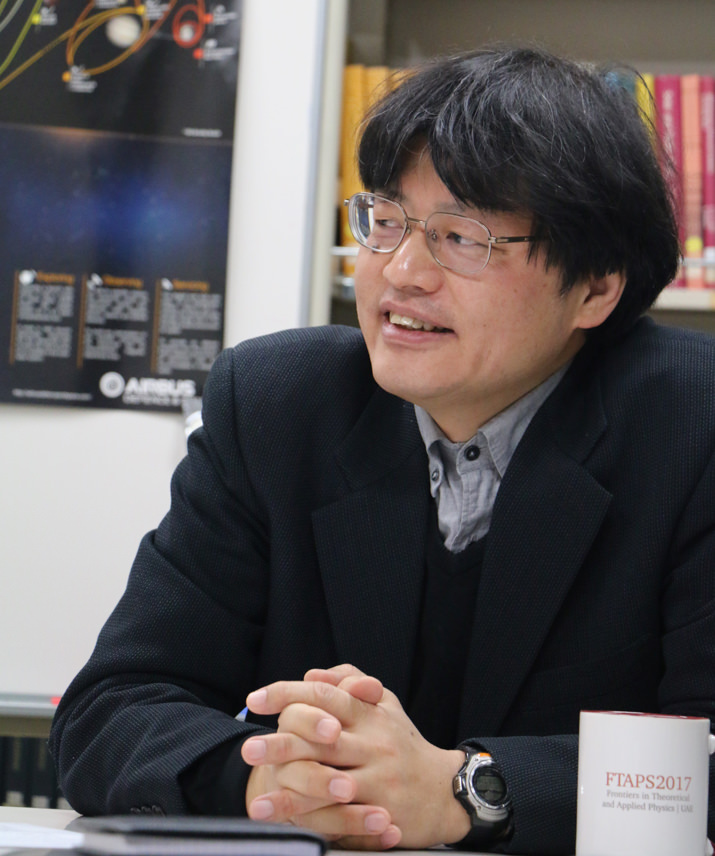
——I’m sure it was difficult to take on both duties, but are you also able to take care of your health?
Dr. Kasaba: Once every two days, I go to bed as early as 9 PM, and, once I’m asleep, I will sleep soundly until 7 AM. The person who first invited me to work on space development and scientific satellites worked incredibly hard and died when he was young, which was a shock to me, and, taking that as a lesson, I make sure that I sleep well, at least.
——You have a good reputation among the students, but what are you particularly mindful of?
Dr. Kasaba: Ultimately, if a student at my university wants to live well as a researcher, my priority is to cooperate with them so that they are able to carefully choose a job that has an impact on neighboring areas and wider areas until they are able to take care of the work with kindness and imagination.
——What are the specifics of this?
Dr. Kasaba:
From the perspective of Tohoku University, JUICE is one more job. The research of Jupiter is also one more job. Originally, at Tohoku University, the starting point for work on Jupiter on various other planets began with observations from above-ground radio telescopes using radio wave observations of astronomical objects and optical telescopes. There are radio telescopes in Fukushima, Miyagi, and other places, and observations can be made with an interferometer that uses multiple telescopes to project onto a telescope with a single large aperture.
The Subaru telescope was established on Mauna Kea in Hawaii, and two telescopes were set up on Haleakala on Maui Island. They have been used to conduct continuous research of Jupiter and the outer planets, which has led to a huge cumulative effect.
The circuitry of the equipment that is being made today has been developed for shared used with underground probe radars (technology that can also be used in underground probes for the moon, mars and asteroids) that are based on above-ground observation. The main theme for this is above-ground and earth-wide technical developments and observations, and, for example, this can be seen in the simulated reproduction of the activity around Jupiter, and in telescopes. Furthermore, Hisaki was of help in the area of computing.
As for the Cassini satellite, which combines multiple scientific areas, performs above-ground observations and developments, numerical simulations, satellite observations (requiring cooperation from the U.S. because of the U.S. Juno satellite), and that is orbiting Saturn, at a mountain for radio wave observation (where data from Cassini is collected), we are working together with the Paris Observatory (a cooperative partner) while using data from Cassini.
We are being allowed to use data from U.S. and European probes, and it’s the same for the Mars probe. This is how we are able to work on JUICE.
This kind of combination in each and every area ends up with results being found in various places. Even from a global point of view, work seems to be taking place very precisely, which makes for good information and a good cooperative relationship.
——Finally, do you have a message for the readers or to future generations?
Message to the Reader
Dr. Kasaba:
The superior technology used for the purpose of space exploration will trickle down to business. In some form, it will assuredly create results as it spreads to various fields throughout Japan, so I would very much like to call for cooperation in the training of the next generation of personnel in the field of space exploration.
Well, more importantly, “space” is a really enjoyable field, and I hope that more and more people will discover that enjoyment!
Interviewed by Nishikawa, Nyan & Co.

